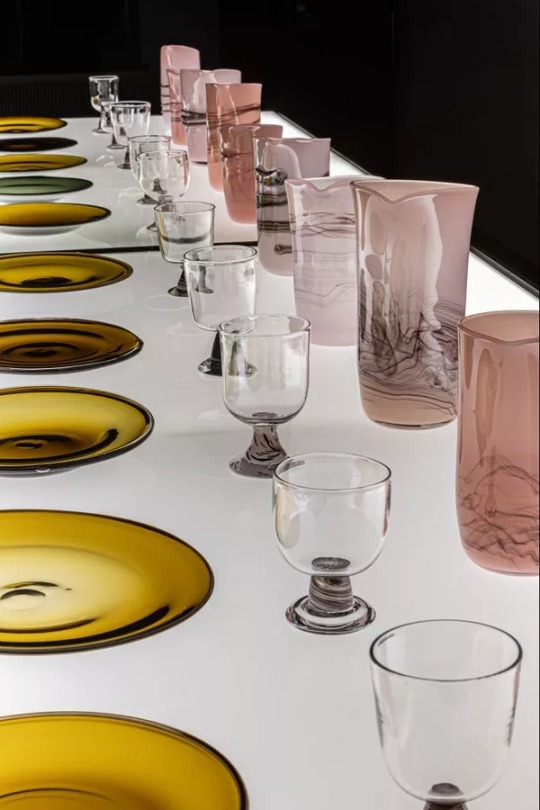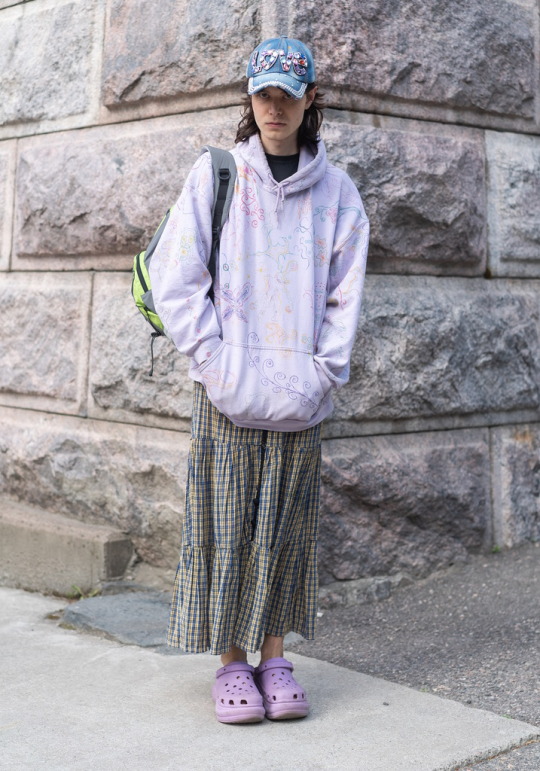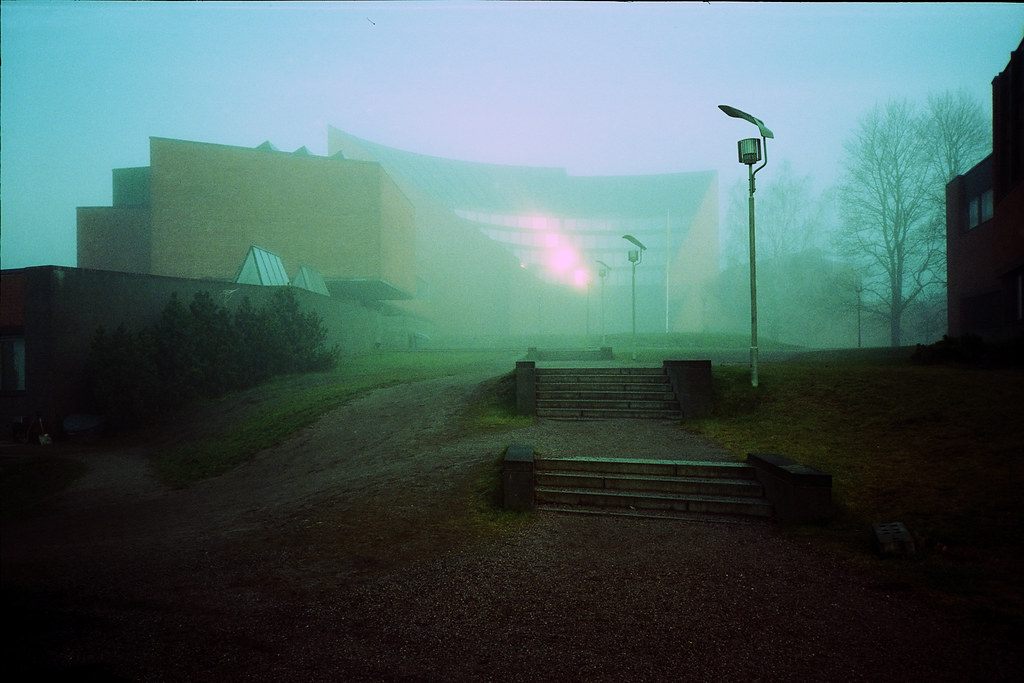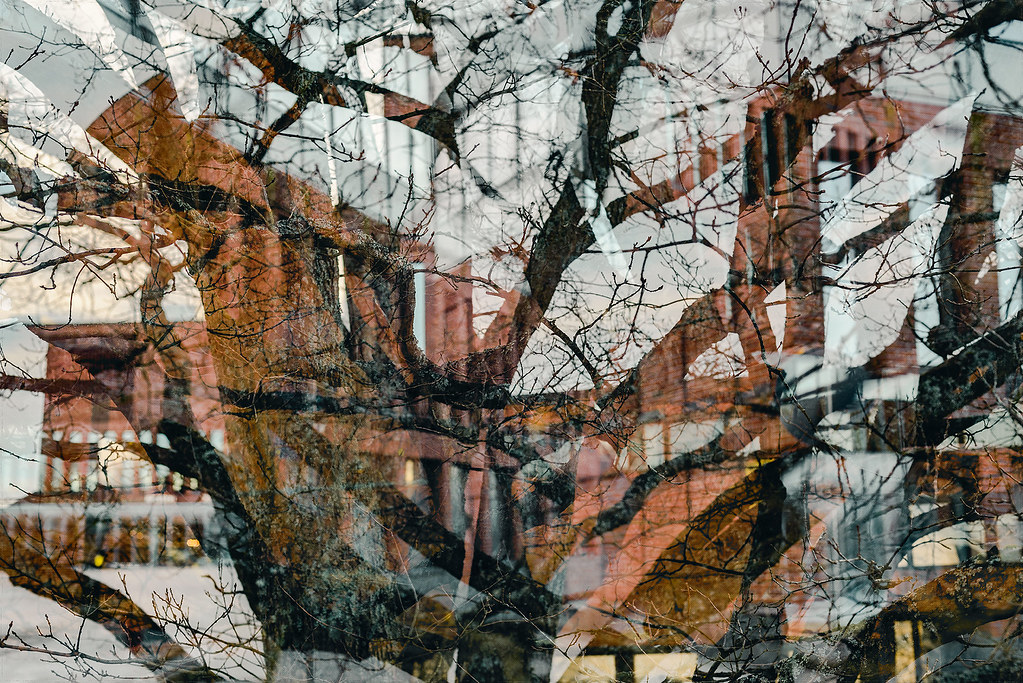#Aalto University
Photo

Paulina, 28
“I’m wearing an aviator coat and leather vest, both are second hand. Dress is from Samsøe Samsøe. My style tip for cold weather is to wear oversized clothes that can be used as a body bag when you freeze to death.”
18 November 2023, Otaniemi
129 notes
·
View notes
Text

A new optical metamaterial makes true one-way glass possible
A new approach has allowed researchers at Aalto University to design a kind of metamaterial that has so far been beyond the reach of existing technologies. Unlike natural materials, metamaterials and metasurfaces can be tailored to have specific electromagnetic properties, which means scientists can create materials with features desirable for industrial applications.
The new metamaterial takes advantage of the nonreciprocal magnetoelectric (NME) effect. The NME effect implies a link between specific properties of the material (its magnetization and polarization) and the different field components of light or other electromagnetic waves. The NME effect is negligible in natural materials, but scientists have been trying to enhance it using metamaterials and metasurfaces because of the technological potential this would unlock.
The work is published in the journal Nature Communications.
Read more.
22 notes
·
View notes
Video
Ripple of Wave by Pekka Nikrus
#building#window#reflection#through#light#interior#exterior#multiexposure#multiple exposure#triple exposure#pni3xp#arts#aalto university#school of arts#design and architecture#taiteiden ja suunnittelun korkeakoulu#aalto-yliopisto#otaniemi#otnäs#väre#espoo#esbo#finland#suomi#pni#pekka nikrus#skrubu#flickr
2 notes
·
View notes
Video

Bubbles! 💭(Charcoal on paper, drawn and erased to document trails of motion)
#riddlemations#2d animation#animation#blackartist#charcoal#traditional animation#Illustration#art#finland#aalto university#ghanaianartist#ghana#reanima#erasmus mundus scholarship
9 notes
·
View notes
Text
New quantum entangled material could pave way for ultrathin quantum technologies - Technology Org
New Post has been published on https://thedigitalinsider.com/new-quantum-entangled-material-could-pave-way-for-ultrathin-quantum-technologies-technology-org/
New quantum entangled material could pave way for ultrathin quantum technologies - Technology Org
Two-dimensional quantum materials provide a unique platform for new quantum technologies, because they offer the flexibility of combining different monolayers featuring radically distinct quantum states. Different two-dimensional materials can provide building blocks with features like superconductivity, magnetism, and topological matter. But so far, creating a monolayer of heavy-fermion Kondo matter – a state of matter dominated by quantum entanglement – has eluded scientists. Now, researchers at Aalto University have shown that it’s theoretically possible for heavy-fermion Kondo matter to appear in a monolayer material, and they’ve described the microscopic interactions that produces its unconventional behavior. These findings were published in Nano Letters.
Artistic illustration depicts heavy-fermion Kondo matter in a monolayer material. Image Credit: Adolfo Fumega/Aalto University
“Heavy-fermion materials are promising candidates to discover unconventional topological superconductivity, a potential building block for quantum computers robust to noise,” says Adolfo Fumega, the first author of the paper and a post-doctoral researcher at Aalto University.
These materials can feature two phases: one analogous to a conventional magnet, and one where the state of the system is dominated by quantum entanglement, known as the heavy-fermion Kondo state. At the transition between the magnetic phase and the heavy-fermion state, macroscopic quantum fluctuations appear, leading to exotic states of matter including unconventional superconducting phases.
Traditionally, heavy-fermion compounds have been studied in bulk materials. Previous investigations carried at Aalto University by the Atomic Scale Physics and Correlated Quantum Materials groups provided the first theoretical and experimental demonstrations of heavy-fermion Kondo matter in van der Waals heterostructures. Two of these papers were published in Nature and Physical Review Letters in 2021.
However, an intrinsic heavy-fermion state in a van der Waals monolayer has remained elusive. Layered van der Waals materials offer new degrees of freedom such as stacking of different layers to engineer heterostructures, twisting the layers to create moiré patterns or applying electric gate voltages, strategies allowing to explore and engineer the different phases of heavy-fermion materials in a controlled way.
The monolayer material researchers analyzed is monolayer CeSiI, a compound that has been recently isolated in the ultrathin limit. Using a combination of many-body and quantum chemistry methods, they showed the nature of competing quantum magnetic interactions in the material, demonstrating that such competition leads to an unconventional quantum entangled state. Furthermore, they showed that the quantum magnetism in this material is dominated by relativistic effects, leading to a subatomic magnetic structure radically different from other two-dimensional materials.
“The discovery of a heavy-fermion quantum material monolayer establishes a fundamental building block for quantum devices,” says Jose Lado, an assistant professor at Aalto University who also heads the Correlated Quantum Materials research group.
Bulk heavy-fermion materials are greatly challenging from the material science point of view, and making devices out of them is a nearly impossible task. With a purely two-dimensional heavy-fermion quantum material and the flexibility of stacking van der Waals layers, a whole new family of quantum devices based on exotic heavy-fermion Kondo phenomena may be developed, opening up yet unexplored directions in quantum technologies.
Source: Aalto University
You can offer your link to a page which is relevant to the topic of this post.
#Aalto University#atomic#atomic scale#Behavior#Building#chemistry#computers#devices#effects#Engineer#experimental#Features#Fundamental#Fundamental physics news#GATE#illustration#it#Link#magnet#magnetism#material#material science#materials#matter#nature#noise#One#Other#paper#patterns
0 notes
Video
Untitled by Samu Kuukka
0 notes
Text
Glass — hand formed matter: Baruth bis 09.07.2023
Schon verschiedentlich hatte ich über dieses Projekt „glass — hand formed matter“ und seine Ausstellungstour berichtet – nun gibt es endlich auch eine Homepage auf der das alles im Detail vorgestellt wird was bisher gut gemeint aber in verwirrender Vielfalt immer neu und anders promoted wird. Spätestens jetzt kann jeder verstehen, warum professionelle Unternehmen so sehr auf ihre Marke und eine…

View On WordPress
#Aalto University#Burg Giebichenstein - Kunsthochschule Halle#colour#construction#drinking culture#ecology#flow#Glas#Glashütte#Glashersteller#Glasherstellung#glass — hand formed matter#Hochschulen#Konstfack#Kunsthochschule Berlin Weissensee#light#manuelle Glasherstellung#Museen#social contexxt#soil#Stiftungen#water#wine
0 notes
Text
The Sound Of The Northern Lights
They might be renowned for their visual spectacle but the #NorthernLights can be heard as well. Find out more here. #Aurora
The ominous red presence of the Northern Lights in the skies of continental Europe was seen as a harbinger of war. In the weeks before the French Revolution a bright red Aurora was seen over Scotland and England with reports of the sound of mighty battles being heard, intriguingly raising the question of whether the Northern Lights made a noise.
One who took the subject seriously was the first…

View On WordPress
#Aalto University#Aurora borealis#Between the Ears#Carl Størmer#Clarence Chant#Northern Lights#Professor Emeritus Lane#Sophus Tromhult#The Shetland News
0 notes
Photo

At the 1939 World’s Fair Alvar Aalto’s Finland Pavilion was one of the most widely received buildings and marked the architect’s breakthrough in the United States. In the the decades following the World’s Fair Aalto would design two additional buildings as well as two interiors that made him frequently return to the US. But Aalto’s relationship with and admiration for the US started way before 1939: Finnish emigration in general and Eliel Saarinen’s 1923 emigration in particular sparked Aalto’s interest in the new world and its architecture, an interest that ultimately resulted in close contacts with architects like William Wurster and Frank Lloyd Wright whom he became friends with on his second US trip in 1939. One year earlier Aalto’s solo exhibition at the MoMA had already put him on the map of progressive influencers who were impressed with Aalto’s „other“ modernism. That these are only some of the many contact points between Aalto and America demonstrates the present publication: „Aalto and America“, edited by Stanford Anderson, Gail Fenske and David Fixler and published by @yalebooks in 2012: along three main sections and sixteen individual essays the book’s contributors provide a detailed analysis of Aalto’s relationship with the United States. After a thorough introduction to the architect’s idea of modernism as technological rationalism and organicism the following essays, among other topics, elucidate how the American prefab industry inspired postwar Finland to produce standardized and prefabricated wooden houses that helped support the starving economy. Conversely, Gail Fenske examines Aalto’s influence on Bay Region architecture as practiced by e.g. William Wurster with whom he shared the notion of a site-specific but decidedly modern architecture. The final part of the book is then fully dedicated to Aalto’s realized US projects, presented in a rich array of drawings, plans and photographs. Special importance is assigned to his Baker House and the revolutionary impact of its facade for which Aalto selected what many perceived as very low-quality bricks.
„Aalto and America“ is a highly readable and thought-provoking book at contains a wealth of little-known aspects of Aalto’s long-term and mutually influential relationship with the United States and its architectural community. A must-read book on Aalto!
#alvar aalto#american architecture#architecture book#architecture#usa#book#monograph#yale university press
46 notes
·
View notes
Video
Prof. Leonard Wantchekon, Princeton University. How 5G Mokki Network Can Impact Global Businesses by Lars Ling
Via Flickr:
The Start North webinar, as a part of Aalto University's 5G Summer School, will explore the potential business prospects for U.S. companies by leveraging Africa's advanced communication and network technology, remote learning, work, and entrepreneurship. These opportunities can also have a positive impact on African economies. Prof. Leonard Wantchekon, Princeton University. www.linkedin.com/in/leonard-wantchekon-ba4bab35/ Press release Aalto University. www.aalto.fi/en/news/5g-mokki-network-can-have-a-huge-imp... APO - African Newsroom: www.africa-newsroom.com/press/5g-mokki-the-african-techno... Live via YouTube: youtu.be/2g3jwPxQqts www.startnorth.com If you are looking for assistance with your CleanTech or Impact business, we can help with financing, acceleration, strategic advisory, and storytelling/PR facilitation. Contact us for business support. Connect with CleanTech Region Impact Group. linktr.ee/cleantechregion Business, Inspiration, and Network in Silicon Valley with Nordic-Baltic Impact Week every year. linktr.ee/nordicimpact Photo and video credit: Lars Ling, Start North. linktr.ee/larsling Copyright (c) All rights reserved.
#5G#summer#school#Aalto#University#Start#North#Helsinki#Espoo#CleanTech#Region#Impact#Group#Africa#Mökki#education#network#Ai#Leonard#Wantchekon#Princeton#flickr
0 notes
Text
EPFL Summer Fellowship in Switzerland 2023-Apply Now
EPFL Summer Fellowship in Switzerland 2023-Apply Now
EPFL Summer Fellowship –There are a number of fellowships and internship opportunities now open to international students at the Ecole Polytechnique federale de Lausanne (EPFL) in Switzerland for the 2023 summer. Applicants may be bachelor or master’s candidates currently enrolled in computer science and related courses.
Participants of the fellowship will have the opportunity to learn new…

View On WordPress
#Aalto University internship programs#E3 EPFL#EPFL 2022#EPFL Computer Science#EPFL Internship in Switzerland#EPFL Summer Fellowship in Switzerland 2023#EPFL summer Internship 2023#EPFL Summer Internship in Switzerland 2022#EPFL summer internship Quora#EPFL summer school high school#ETH Summer Internship in Switzerland#ETH Zurich Summer Internship 2022#Summer Internship Switzerland#Switzerland Summer research Internship#UNIL Summer Internship
0 notes
Photo

Olli
“I’m wearing a thrifted cap, skirt and backpack, my platform Crocs and a hoodie I customized with my friend Iida Saarela. I'm inspired by magic.”
27 May 2023, Kasarmikatu
#hel looks#street snap#street style blog#street style#helsinki street style#Helsinki Finland#Aalto University
204 notes
·
View notes
Photo

Lab-grown pigments and food by-products: The future of natural textile dyes
As the environmental impact of the fashion and textile industries becomes clearer, the demand and need for sustainable alternatives is growing. One international research group aims to replace toxic synthetic dyes with natural alternatives, ranging from plants to microbes to food waste.
Walk into any clothing store and you'll find a rainbow of fluorescent shirts, pastel sweaters and blue jeans that rotate in and out of style each season. The colors of each garment are pristine, eye-catching and identical, but there are consequences hidden in those racks of colorful clothes.
Our planet and the factory workers producing our clothes are paying a steep price: toxic chemicals used in the synthetic dyeing process pollute waterways and soil.
Introduced in the 1860s, synthetic dyes and pigments have become commonplace in the textile industry. These dyes are part of the reason why clothes of every color imaginable are so readily available: they offer quick and easy alternatives to the natural sources of color that used to be the only option.
Read more.
262 notes
·
View notes
Video
Outnes by Pekka Nikrus
Via Flickr:
➡️ in-camera multiple exposures
#building#tree#branches#multiexposure#multiple exposure#triple exposure#pni3xp#otaniemi#otnäs#aalto university#aalto-yliopisto#aalto universitetet#espoo#esbo#finland#suomi#pni#pekka nikrus#skrubu#flickr
0 notes
Text
Scientists Reveal New Images of a Black Hole - Proof of a Persistent Black Hole Shadow - Technology Org
New Post has been published on https://thedigitalinsider.com/scientists-reveal-new-images-of-a-black-hole-proof-of-a-persistent-black-hole-shadow-technology-org/
Scientists Reveal New Images of a Black Hole - Proof of a Persistent Black Hole Shadow - Technology Org
The Event Horizon Telescope (EHT) researchers published the first image of a black hole and its shadow in 2019, showing a bright ring with a dark circular area in the centre, the shadow of the black hole.
The new 2018 observations reveal a bright emission ring around the black hole of the same size as in 2017, with the brightest part of the ring shifted by about 30 degrees between observations. Image credit: EHT
The Event Horizon Telescope Collaboration has released new images of the supermassive black hole at the centre of the galaxy Messier 87. Researchers from Aalto University and the University of Turku contributed to forming the images from the new observations.
The groundbreaking image showed that the giant galaxy Messier 87 has a supermassive black hole M87* at its centre. The black hole resides 55 million light-years from Earth.
Now, the research team has published a new image of the M87* black hole based on more recent and more precise observations taken in 2018. With the participation of the newly commissioned Greenland Telescope and a dramatically improved recording rate across the array, the 2018 observations give us a view of the source independent from the first observations in 2017.
According to the theory of general relativity, the size of the ring around a black hole depends mainly on the mass of the black hole. Based on this, the researchers assumed that the ring in the new image remains the same.
The new images show the M87* black hole with a bright ring around it, similar to and the same size as the one observed in 2017. This result confirms the research team’s earlier breakthrough.
“A fundamental requirement of science is to be able to reproduce results,” says Dr. Keiichi Asada, an associate research fellow at Academia Sinica Institute for Astronomy and Astrophysics in Taiwan. “Confirmation of the ring in a completely new data set is a huge milestone for our collaboration and a strong indication that we are looking at a black hole shadow and the material orbiting around it.”
The image now released confirms the original findings, but there are also small differences between the images.
“The brightness peak at the bottom of the ring has shifted by about 30 degrees. This observation supports our idea that there is a turbulent, magnetized accretion flow around the black hole, variations of which are causing the location of the brightness peak to fluctuate between the observations,” says Tuomas Savolainen of Aalto University, who was involved in the study.
Researchers from Aalto University and the University of Turku participated in the calibration and analysis of the EHT data and contributed to forming the images from the new observational data.
“We used both traditional algorithms and new methods based on statistical analysis to create the images. When using the new statistical methods, we also made use of the CSC supercomputers to generate the images. The computing time used was equivalent to a thousand years on a single laptop computer,” says Kaj Wiik from the University of Turku.
Venkatessh Ramakrishnan from the Finnish ESO Centre also participated in the study. The EHT collaboration involves more than 300 researchers from around the world. The international collaboration is working to capture the most detailed black hole images ever by creating a virtual Earth-sized telescope.
Source: Aalto University
You can offer your link to a page which is relevant to the topic of this post.
#Aalto University#Algorithms#Analysis#Astronomy#Astronomy news#Astrophysics#black hole#Capture#Collaboration#computer#computing#Dark#data#earth#Featured Space news#Fundamental#Fundamental physics news#Galaxy#general relativity#Greenland#Horizon#images#it#laptop#Light#Link#mass#material#milestone#One
0 notes
Text
A species of spider lives its entire life underwater, despite having lungs that can only breathe atmospheric oxygen. How does it do it? This spider, known as the Argyroneta aquatica, has millions of rough, water-repellent hairs that trap air around its body, creating an oxygen reservoir and acting as a barrier between the spider's lungs and the water.
This thin layer of air is called a plastron and for decades, material scientists have been trying to harness its protective effects. Doing so could lead to underwater superhydrophobic surfaces able to prevent corrosion, bacterial growth, the adhesion of marine organisms, chemical fouling, and other deleterious effects of liquid on surfaces. But plastrons have proved highly unstable under water, keeping surfaces dry for only a matter of hours in the lab.
Now, a team of researchers led by the Harvard John A. Paulson School of Engineering and Applied Sciences (SEAS), the Wyss Institute for Biologically Inspired Engineering at Harvard, the Friedrich-Alexander-Universität Erlangen-Nürnberg in Germany, and Aalto University in Finland have developed a superhydrophobic surface with a stable plastron that can last for months under water.
Continue Reading
101 notes
·
View notes

